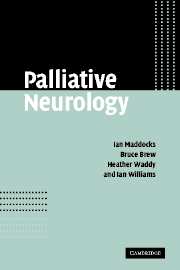Book contents
- Frontmatter
- Contents
- Foreword
- Note on drugs and abbreviations
- Section I Palliative Management
- 1 Introduction to palliation
- 2 Characteristics of palliation
- 3 Nodal points in decision-making
- 4 Common deficiencies in palliative management
- 5 Common themes in palliation practice
- Section II Major discomforts in advanced neurological illness
- Section III Major neurological conditions requiring palliation
- Section IV Ethical issues
- Section V Appendices
- Index
4 - Common deficiencies in palliative management
from Section I - Palliative Management
Published online by Cambridge University Press: 08 January 2010
- Frontmatter
- Contents
- Foreword
- Note on drugs and abbreviations
- Section I Palliative Management
- 1 Introduction to palliation
- 2 Characteristics of palliation
- 3 Nodal points in decision-making
- 4 Common deficiencies in palliative management
- 5 Common themes in palliation practice
- Section II Major discomforts in advanced neurological illness
- Section III Major neurological conditions requiring palliation
- Section IV Ethical issues
- Section V Appendices
- Index
Summary
POOR COMMUNICATION
Communication is a two-way process, and liable to be inhibited by factors that limit the ability of either party to enter into a full and free exchange. In the acute in-patient setting a clinician's communications are usually clearly directed and brief, focused on immediate problems and providing crisp management strategies and prescriptions. When the patient response is inhibited or slowed by changes in appreciation (as in dementia, deafness or delirium) or in expression (as in a large number of neurodegenerative conditions) there is a temptation for attending persons to be impatient, to guess at need, to assume permission for new interventions, to accept a role of speaking at the patient rather than exchanging with the patient. It is always worth remembering that impairment that creates difficulty or inability to communicate does not necessarily indicate a lack of awareness or understanding.
Impaired communication may originate from focal cerebral lesions, causing:
aphasia: an inability to cope with both the reception and expression of information;
agnosia: a failure to give meaning to stimuli which are received; or
apraxia: a disturbance of voluntary intent in movement (in this case of the muscles serving speech), so that some automatic responses may come through, but the processing of thought into action is impaired.
Dysarthria, and paresis affecting respiration, laryngeal function or movements of the tongue, palate or lips will inhibit expression even when there may be clarity of thought. Confusion may result from metabolic changes, medication side-effects, and numerous other causes.
- Type
- Chapter
- Information
- Palliative Neurology , pp. 25 - 32Publisher: Cambridge University PressPrint publication year: 2005



